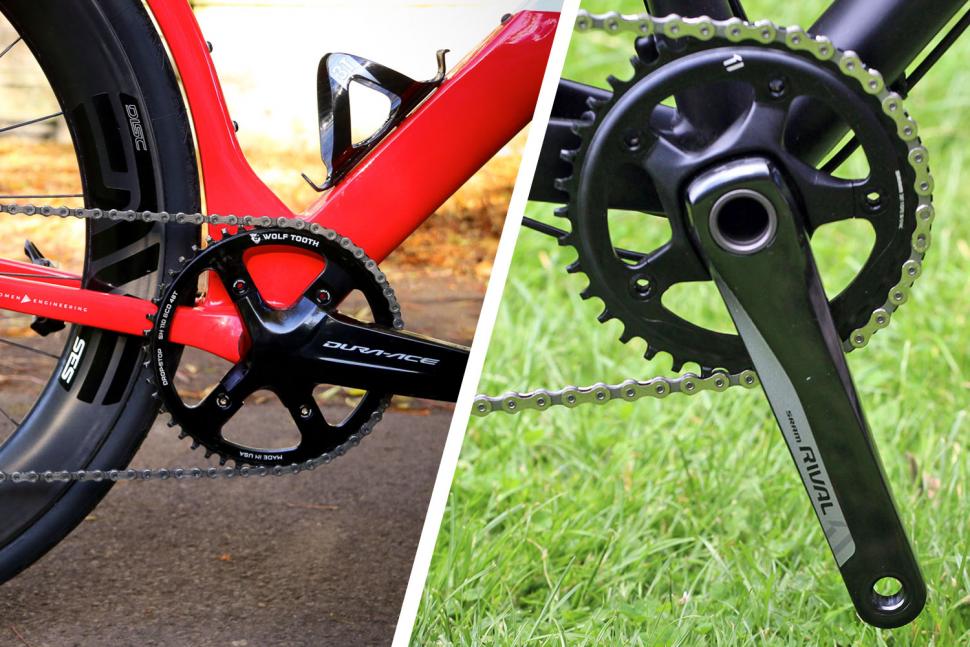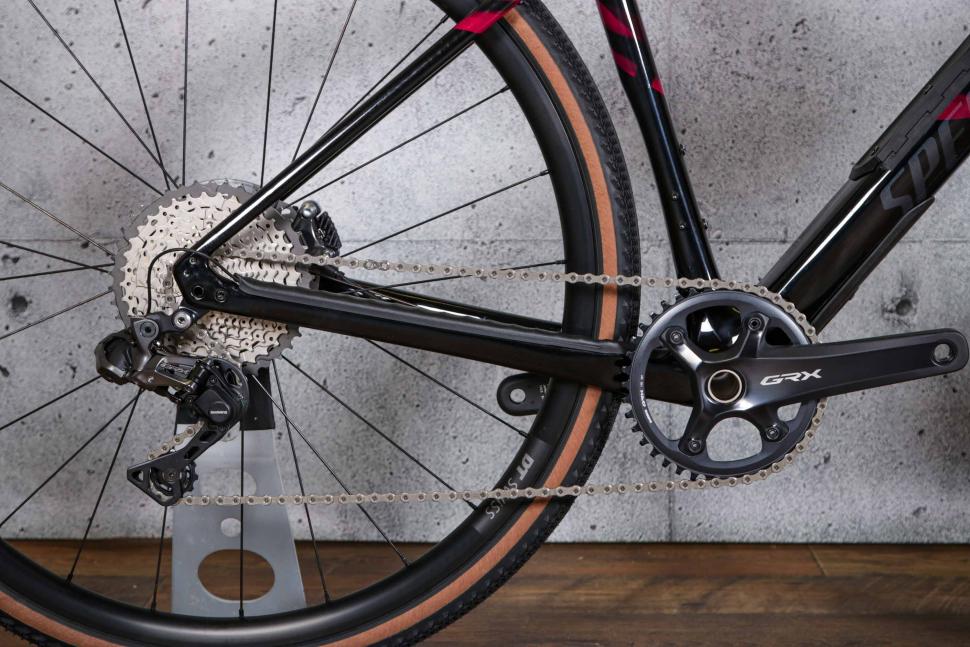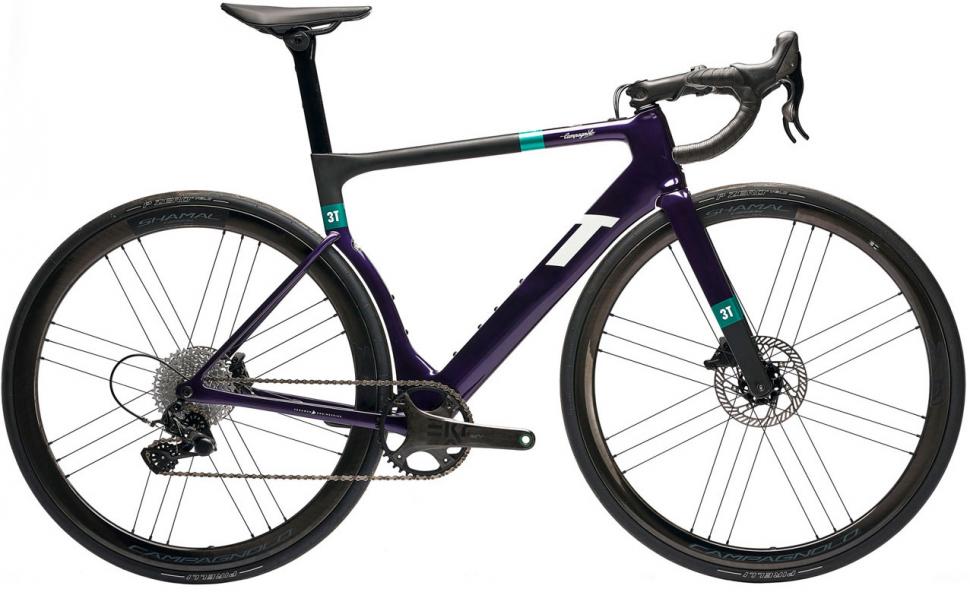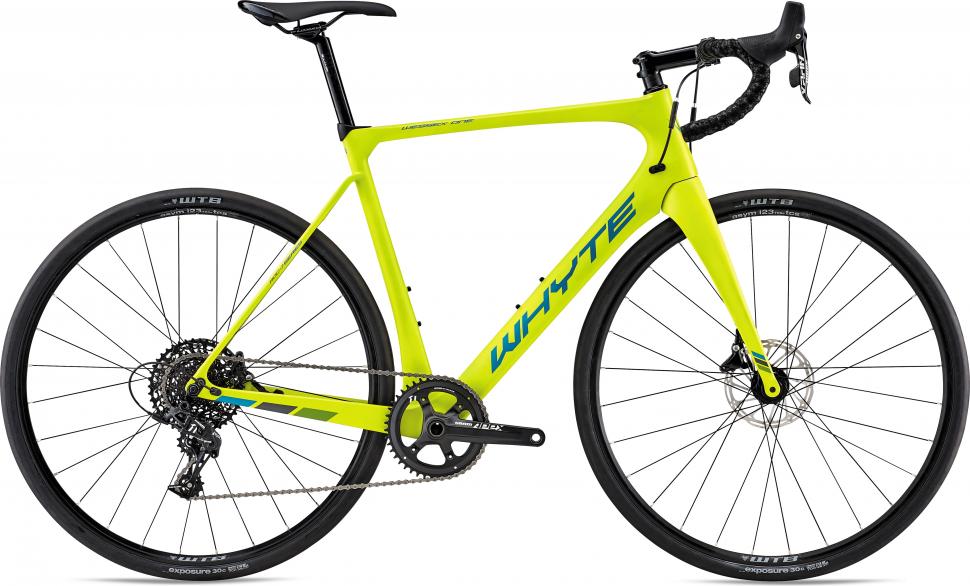- News
- Reviews
- Bikes
- Accessories
- Accessories - misc
- Computer mounts
- Bags
- Bar ends
- Bike bags & cases
- Bottle cages
- Bottles
- Cameras
- Car racks
- Child seats
- Computers
- Glasses
- GPS units
- Helmets
- Lights - front
- Lights - rear
- Lights - sets
- Locks
- Mirrors
- Mudguards
- Racks
- Pumps & CO2 inflators
- Puncture kits
- Reflectives
- Smart watches
- Stands and racks
- Trailers
- Clothing
- Components
- Bar tape & grips
- Bottom brackets
- Brake & gear cables
- Brake & STI levers
- Brake pads & spares
- Brakes
- Cassettes & freewheels
- Chains
- Chainsets & chainrings
- Derailleurs - front
- Derailleurs - rear
- Forks
- Gear levers & shifters
- Groupsets
- Handlebars & extensions
- Headsets
- Hubs
- Inner tubes
- Pedals
- Quick releases & skewers
- Saddles
- Seatposts
- Stems
- Wheels
- Tyres
- Health, fitness and nutrition
- Tools and workshop
- Miscellaneous
- Buyers Guides
- Features
- Forum
- Recommends
- Podcast
 Is the front mech dead Sept 2018
Is the front mech dead Sept 2018Is the front mech dying? Is there a future for the front derailleur on modern road bikes?
First published November 4, 2017
With more and more sprockets on our wheels, do we still need two chainrings up front? We take a deep dive into the pros and cons of 1X gearing.
The drivetrain on a modern road bike has evolved loads since the early days when you turned a lever to move the chain to a different sprocket. Electronics are now commonplace and cassettes with ever-wider ranges provide enough gears to tackle even the steepest mountain climbs.
Most modern road bikes use two derailleurs to move the chain across the cassette and chainset, and it works well thanks to many years of product development. We probably take them for granted. But there's a move in some parts of the cycling world to simplify the drivetrain and it threatens the future existence of the front derailleur.
The arrival of SRAM’s 1x11 drivetrain a few years ago, a gear system that ditched the front mech and instead combined a single chainring with a wide-range cassette, provided another path. Such drivetrains have become hugely popular on mountain bikes and we've seen cyclocross and gravel bikes also being specced with single chainsets in recent years. Could the same happen to road bikes?
What are the benefits of 1X gearing?
The simplicity is certainly appealing. With just one shifter, changing gear is much more intuitive than having to manage the front and rear derailleurs. For beginners, that's an obvious benefit. There’s one less component to fail as well (though front derailleur failures are rare) and on bikes designed for wider tyres, removing the front derailleur can provide additional clearance around the rear wheel and seat tube area.
Read more: Beginner's guide: understanding gears
A short history of the front derailleur
Early users of double chainsets didn't even bother with front derailleurs; they pushed the chain from the large to small chainring with their heels at the bottom of a long climb, then stopped at the top of the hill to manually lift it back to the big ring. In the 1930s, French cycle tourists began using mechanisms to move the chain, as they realised being able to change gears was useful on the flat as well as when you had a long climb ahead.
Front derailleurs of the 1930s were usually actuated by cables; rod-operated front derailleurs appeared in the 1940s, and provided very quick and efficient shifts. You had to reach down towards the bottom bracket to operate them, which looks awkward to modern riders who are used to brake/shift levers, but was reportedly quite straightforward.
Read more: First Ride: SRAM 1x Road
Since then, the front derailleur really hasn't changed much at all. It's still a basic component, comprising two metal plates that shove the chain across the chainrings, and the stiffer those plates the better the shifting. But making plates stiffer by making them thicker also adds weight, so gear makers have added ramps and pins to the chainrings, bringing a real improvement in front shifting performance. The biggest recent development has been the addition of a motor in the electronic systems made by Shimano, Campagnolo, SRAM and FSA.
The 1x charge – the industry speaks
But the cycle industry is in a great period of technological development at the moment and everything is up for change. Chainsets have evolved from triples to doubles over the years with loads of configurations available, but a definite trend towards lower ratio setups like a compact, semi-compact and most recently, sub-compact. So if lower gears are popular, why not go all the way and use a smaller single ring?
For mountain biking, a single ring chainset makes a lot of sense. Changing gears is easier with just one gear shifter, there's one less thing to malfunction, mud and ground clearance is improved, weight is lowered and suspension designers are freed from the limitations of having to factor in a front derailleur when locating pivots. And any loss in gear range is compensated for by a wide-range cassette, with SRAM’s introduction of a 10-42t cassette and more recently 10-50t with its 12-speed Eagle groupset.
SRAM has been instrumental in the popularity of single ring drivetrains, but SRAM’s Global Drivetrain Category Manager Ron Ritzler doesn’t think fans of the front derailleur need to worry just yet.
"Will the front derailleur disappear? Probably not yet as there are certain users, like some elite athletes, who need the range and the steps to perform at their best – but can it kill the front derailleur for users who spend their time in cyclocross, commuting, adventure riding and in events where fast precise single ring performance is preferred; heck yes,” he tells us.
“We still make front derailleur and 2x rings that work really perfectly, but we love the fact that there are some many people using road bikes in new ways that make 1x the right choice."
While SRAM has been cheerleading the benefits of single ring drivetrains, Shimano isn’t really embracing it. Shimano’s Ben Hillsdon says the versatility of the double ring setup is just too good to ignore.
“Essentially the front derailleur doubles the number of gear ratios available to a rider, and, therefore, gives riders smaller steps in shifting between their biggest gear and their lowest gear,” he says. “That means riders have a wider range of gears, a smoother pedalling experience and their cadence (ie leg speed) can stay constant.
“That, in turn, brings a physiological benefit as muscles and joints are saved from being overworked, which can be crucial when it comes down to the sharp end of a race. The versatility of a double-ring setup is that you can go anywhere without compromise. However, for those riders choosing simplicity, our strategy is to offer drivetrains that can be set up in many different ways for different styles of riding.”
Read more: Your complete guide to SRAM road bike groupsets
Since we spoke to Ben Hillsdon, Shimano has backtracked a little though, introducing 1X options in the GRX range of gravel bike components. Okay, a gravel bike isn't a road bike, but there's no reason you couldn't use a gravel bike transmission on a road bike as long as you can get a top gear high enough for mountain descents and sprint finishes.
In fact, that's exactly what 3T have done with their Strada road bike, which now comes in a version with Campagnolo's 1X13 Ekar components. Ekar is intended for gravel bikes, but 3T clearly don't believe in discipline boundaries, and who's to say they're wrong?
But a front derailleur gives you more gears, right?
One of the biggest advantages of the front derailleur was a big increase in the range of gears. That was an obvious advantage with a 5-speed cassette many decades ago. Over the years, the number of sprockets on the cassette has increased and is now up to 11, 12 or even 13.
Not only has the sprocket number increased, but the size of the sprockets has gone up: most racers predominantly used 12-23 cassettes a few years ago, but 11-30 is now common in the pro peloton and many sportive bikes now come with 11-34 cassettes.
Of course, removing one of the chainrings reduces your available range so to combat this SRAM introduced a whopping 10-42 cassette. It was instrumental in winning over mountain bikers as it was possible for a single ring drivetrain to offer nearly the same gear range as a conventional compact drivetrain.
Read more: SRAM Rival 1 review
How does a single ring drivetrain compare to a conventional drivetrain? Favourably, if you look at the numbers. Combine a 44-tooth single chainring with an 11-36 cassette and you have a gear range from 33 to 108 inches. That’s very nearly the same as the 32.8 to 122.7 range that a 50/34 and 11-28 setup provides, a setup many riders still use, though the latest off-the-peg bikes tend to have an 11-32 or 11-34 cassette.
You can adjust the size of the chainring and the cassette to tailor that gear range to suit the geography of your local terrain and riding style, whether solo touring rides or racing, much like you modify a current drivetrain with different chainsets and cassettes depending on whether you want top-end for racing or low-end for riding in the mountains.
While the gear range compares favourably, where the 1x setup falls short is in the jumps between the gears. This will concern those cyclists who like to be in the perfect gear for the optimum cadence at all times. How big a concern the larger jumps between gears will be to you depends largely on the type of cyclist you are, the sort of riding you do and your terrain. There is much work being done to provide cassettes that can help smooth the transition in the most frequently used gears, with 3T's Gerard Vroomen developing two versions of a 9-32t cassette that looks to be a good choice.
So should you ditch the front derailleur?
That depends. There are clear advantages and disadvantages to a 1X drivetrain at present. It’s unlikely we’ll see the front derailleur confined to the history books anytime soon, especially given Shimano’s dominant position in the market. That'll certainly be the case for regular road bikes and especially race bikes where tradition rules.
Where we're seeing single ring drivetrains really start to become a lot more popular is on bikes where the disadvantages are outweighed by the advantages offered by a simplified drivetrain, where the ultimate range isn't as critical and where the bigger jumps aren't as much of an issue.
Read more: Will your next bike be a gravel bike?
We’re talking about cyclocross bikes (where many racers have been going single ring for many years already with home-brewed solutions) and the gravel and adventure bike category where 1X is as common a transmission option as 2X. But with the likes of the 3T Strada and Whyte Wessex One, two road bikes designed around 1x11 drivetrains, we could be looking at more road bikes devoid of front derailleurs in the future.
Ultimately, though, the modern double-chainring transmission is too good for many cyclists to want to make a radical change. But the rise of wide-range cassettes does provide an interesting alternative that will appeal to many cyclists, which means we might see a few less front derailleurs on road bikes in the future.
Do you ride a bike with a single ring drivetrain?
David worked on the road.cc tech team from 2012-2020. Previously he was editor of Bikemagic.com and before that staff writer at RCUK. He's a seasoned cyclist of all disciplines, from road to mountain biking, touring to cyclo-cross, he only wishes he had time to ride them all. He's mildly competitive, though he'll never admit it, and is a frequent road racer but is too lazy to do really well. He currently resides in the Cotswolds, and you can now find him over on his own YouTube channel David Arthur - Just Ride Bikes.
Latest Comments
- Veloism 10 sec ago
"every other urban hipster is wearing one of these just for the style points"...
- quiff 1 min 17 sec ago
Pretty sure the Carradice Odyssey didn't exist when I got my Wizard Works Shazam - they had the traditional cotton duck bags or the Super-C. Wizard...
- Olbol156 3 min 50 sec ago
Charged with careless driving.
- brooksby 7 min 7 sec ago
Much as i suspect that she's a NIMBY who enjoys living in an open air museum, she may have a point if it's true that there are other parts where...
- Rendel Harris 11 min 36 sec ago
If you live in London you get used to a rough average of one close pass every 5 km or so, or 10 a day if you ride 50 km most weekdays as I do....
- Secret_squirrel 36 min 12 sec ago
As much as I'd like to join you on this soap box the Active Travel funding is ring fenced afaik....
- wycombewheeler 53 min 57 sec ago
what about super round wheels? can they be kept exclusive?
- wycombewheeler 56 min 8 sec ago
Here's an argument for firearms. If he hadn't had a shotgun he would probably have tried with the car unneccesarily mahoosive truck a second time,...
- youngoldbloke 1 hour 9 min ago
"Turner can often be seen using sandpaper to taper the end/lead of a pencil to ensure the finest of points." So? That's just what you do if you are...
- qwerty360 1 hour 59 min ago
The other issue with proportionality is on rate of offence being prosecuted;...





Add new comment
125 comments
I was thinking of getting a 28-40 chain set and fitting a 44 for special events on my Arkose. Does it work well on a CX bike?
Although 11-32, nothing as bonkers as 11-40!
Yes perfectly, it is at the maximum range on the crankset because the front derailleur cage wont allow anything more. There is one benefit with XT Di2 is that the electronics wont allow the rear derailleur to cross chain small/small. It stops the rear derailleur moving onto last 4 sprockets. This keeps the chain from rubbing on the front derailleur lower section. Ive now fitted Syncroshift display- that works beautifully.
I tried several front outer chainrings to get the correct fit and look. I needed longer steel outer crank bolts to create the clearance between the inner and outer rings(steel has shallower heads).
I use an 11-32 cass for general riding, only use 11*40 for alpine type climbs
If you want more info just ask.
No that's fine. Was thinking of doing the southdowns way and want a bigger range of gears. the MTB chainset seems to be the cheapest way of achiveing that. Thanks for the advice.
Its not quite dead yet (shame) but will be once the next generation of cassettes and hubs arrive to correctly facilitate the range needed. It seems the optimal one will be 12spd, with an xd driver with a 9or10-40 cassette and a 40T ring.
I see it different. I think 12 gears in a 400% range is too few; some of the gaps too large. And 12 gears in a 444% range would leave some very uncomfortably tall steps between gears.
When you combine the common 50/34 or 52/36 front cranksets with the ubiquitous 11-28 cassette, you get a range that's well under 400%. Any serious road 1x system needs to be optimized to replace these set-ups, then have options for wider range.
When there's a 10-36 or 11-40 13-speed cassette and rear mech, you'll have my attention. As a flat-lander, I could even get by with an 10-32 or 11-36 12 speed setup, but I don't see that as a viable option for the mass market.
Pages